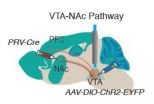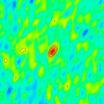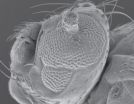(Press-News.org) A specific pattern of neuronal firing in a brain reward circuit instantly rendered mice vulnerable to depression-like behavior induced by acute severe stress, a study supported by the National Institutes of Health has found. When researchers used a high-tech method to mimic the pattern, previously resilient mice instantly succumbed to a depression-like syndrome of social withdrawal and reduced pleasure-seeking – they avoided other animals and lost their sweet tooth. When the firing pattern was inhibited in vulnerable mice, they instantly became resilient.
"For the first time, we have shown that split-second control of specific brain circuitry can switch depression-related behavior on and off with flashes of an LED light," explained Ming-Hu Han, Ph.D., of the Mount Sinai School of Medicine, New York City, a grantee of NIH's National Institute of Mental Health (NIMH). "These results add to mounting clues about the mechanism of fast-acting antidepressant responses."
Han, Eric Nestler, M.D., Ph.D., of Mount Sinai, and colleagues, report on their study online, Dec. 12, 2012, in the journal Nature.
In a companion article, NIMH grantees Kay Tye, Ph.D., of the Massachusetts Institute of Technology, Cambridge, Mass., and Karl Deisseroth, M.D., Ph.D., of Stanford University, Stanford, Calif., used the same cutting-edge technique to control mouse brain activity in real time. Their study reveals that the same reward circuit neuronal activity pattern had the opposite effect when the depression-like behavior was induced by daily presentations of chronic, unpredictable mild physical stressors, instead of by shorter-term exposure to severe social stress.
Prior to the new studies, Han's team suspected that a telltale pattern – rapid firing of neurons that secrete the chemical messenger dopamine in a key circuit hub – makes an animal vulnerable to the depression-like effects of acute severe stress, and that slower firing supports resilience. But they lacked direct, real-time evidence.
To pinpoint cause-and-effect, they turned to a research technology pioneered by Deisseroth, called optogenetics. It melds fiber optics and genetic engineering to precisely control the activity of a specific brain circuit in a living, behaving animal. Genetically modified viruses are used to inject light-reactive proteins, borrowed from primitive organisms like algae, to make the circuitry similarly light-responsive.
The researchers had previously shown that neurons in the reward circuit hub deep in the brain, called the ventral tegmental area (VTA), fire at normal rates in social stress-resilient mice, but at high rates in social stress-susceptible mice. So they embedded an LED-lit optical fiber aimed at the VTA circuitry of genetically modified resilient mice to convert them into susceptible mice by triggering high firing rates.
Normally, it takes 10 days of repeated encounters with a dominant animal – an experimental procedure called social defeat stress – to induce depression-related behaviors. Even after that, some mice emerge seemingly unscathed. But these resilient animals – in which the reward circuit had been genetically modified for optogenetic control – instantly succumbed to a long-lasting depression-like syndrome after light pulses triggered neural activity mimicking the high firing rates seen in the susceptible animals.
In subsequent experiments, using similar optogenetic strategies, the researchers discovered that inhibiting the reward circuit activity pattern in stress-susceptible mice instantly converted them into stress-resilient animals. The reward circuit projects from the VTA to an area in the center front of the brain, called the nucleus accumbens. This study suggests that dopamine neurons firing at high rates in this specific circuit projection encode a signal for susceptibility to depression induced by acute, severe stress. By contrast, a circuit projection from the VTA to the prefrontal cortex, in the top front of the brain (see diagram), was found to serve an opposite function.
Depression in humans often stems from milder stressors over longer periods of time. Tye and Deisseroth used optogenetics to probe reward circuit workings related to depression-like behaviors in rodents exposed to stressors like white noise, crowded housing, or continuous darkness or illumination. Exposure to some of these milder stressors lasted 10 weeks, compared to the 10-days of social defeat stress.
"We sought to mimic gradual, stress-induced transitions to depressed-like states, as are often seen clinically," explained Deisseroth, who is a practicing psychiatrist as well as a neuroscientist.
In contrast to the Han-Nestler results after social defeat stress, following 10 weeks of unpredictable chronic mild stress, optogentically inducing high firing rates in VTA dopamine neurons instantly reversed such depression-like behaviors induced by chronic mild stressors – and vice versa. Also opposite to the social defeat stress findings, optogenetically inhibiting VTA dopamine neurons induced depression-like states.
"The variable effects that stressors of different types induce in the dopamine system may point to the need for distinct treatment strategies for patients whose depressions stem from different types of experiences," said Tye, who is leading a research group studying the neural underpinnings of motivational and emotional processing.
When Tye and Deisseroth infused agents that block binding of the chemical messenger glutatmate in the nucleus accumbens, they produced an antidepressant response – mice struggled more to escape the stressor. They note that this is consistent with the effects of the fast-acting antidepressant ketamine, which similarly blocks glutamate.
While optogenetics is providing insights into rapid antidepressant mechanisms, the technique is not suitable for treatment of depression in humans.
"These stunning demonstrations that depression-like states can literally be switched on and off underscore that context – stressor type and intensity – is pivotal in the workings of the neurons and circuit implicated," said NIMH Director Thomas R. Insel, M.D. "These new, precise circuit breakers are advancing our understanding of how specific brain pathways regulate behavior."
INFORMATION:
References:
Chaudhury D, Walsh JJ, Friedman AK, Juarez B, Ku SM, Koo JW, Ferguson D, Tsai H-C, Pomeranz L, Christoffel DJ, Nectow AR, Ekstrad M, Domingos A, Mazie-Robison M, Mouzon E, Lobo MK, Neve RL, Friedman JM, Russo SJ, Diesseroth K, Nestler E, Han M-H. Rapid regulation of depression-related behaviors by control of midbrain dopamine neurons. Dec. 12, 2012. Nature.
Tye KM, Mirzabekov JJ, Warden MR, Ferenczi EA, Tsai H-C, Finkelstein J, Kim S-Y, Adhikari A, Thompson KR, Andalman AS, Gunaydin LA, Witten LB, Deisseroth K. Dopamine neurons modulate neural encoding and expression of depression-related behaviour. Dec. 12, 2012. Nature
NIH Grants
F32 MH880102
RO1 MH99647
RO1 MH092306
F31 MH095425
F32 MH096464
The mission of the NIMH is to transform the understanding and treatment of mental illnesses through basic and clinical research, paving the way for prevention, recovery and cure. For more information, visit http://www.nimh.nih.gov.
About the National Institutes of Health (NIH): NIH, the nation's medical research agency, includes 27 Institutes and Centers and is a component of the U.S. Department of Health and Human Services. NIH is the primary federal agency conducting and supporting basic, clinical, and translational medical research, and is investigating the causes, treatments, and cures for both common and rare diseases. For more information about NIH and its programs, visit http://www.nih.gov.
Stress-resilience/susceptibility traced to neurons in reward circuit
Light instantly triggers or reverses depression-like states in rodents -- NIH-funded studies
2012-12-13
ELSE PRESS RELEASES FROM THIS DATE:
Astronomers catch jet from binge-eating black hole
2012-12-13
Back in January, a new X-ray source flared and rapidly brightened in the Andromeda galaxy (M31), located 2.5 million light-years away. Classified as an ultraluminous X-ray source (ULX), the object is only the second ever seen in M31 and became the target of an intense observing campaign by orbiting X-ray telescopes -- including NASA's Swift -- and radio observatories on the ground. These efforts resulted in the first detection of radio-emitting jets from a stellar-mass black hole outside our own galaxy.
A ULX is thought to be a binary system containing a black hole that ...
Protein strongest just before death
2012-12-13
Researchers at Michigan State University have discovered a protein that does its best work with one foot in the grave.
The study, which appears in the current issue of the Journal of Biological Chemistry, focuses on the nontraditional lifestyle of Retinoblastoma tumor suppressor proteins, which could lead to new ways to treat cancer.
"Retinoblastoma proteins are unique in that they use controlled destruction to do their jobs in a timely but restrained fashion," said Liang Zhang, a lead author and MSU cell and molecular biology graduate student. "This is an unusual way ...
Experimental agent briefly eases depression rapidly in test
2012-12-13
A drug that works through the same brain mechanism as the fast-acting antidepressant ketamine briefly improved treatment-resistant patients' depression symptoms in minutes, with minimal untoward side effects, in a clinical trial conducted by the National Institutes of Health. The experimental agent, called AZD6765, acts through the brain's glutamate chemical messenger system.
Existing antidepressants available through prescription, which work through the brain's serotonin system, take a few weeks to work, imperiling severely depressed patients, who can be at high risk ...
Study reveals new factor that could limit the life of hybrid and electric car batteries
2012-12-13
COLUMBUS, Ohio – A new study of the batteries commonly used in hybrid and electric-only cars has revealed an unexpected factor that could limit the performance of batteries currently on the road.
Researchers led by Ohio State University engineers examined used car batteries and discovered that over time lithium accumulates beyond the battery electrodes – in the "current collector," a sheet of copper which facilitates electron transfer between the electrodes and the car's electrical system.
This knowledge could aid in improving design and performance of batteries, explained ...
NASA sees newborn Tropical Storm Evan causing trouble for American Samoa
2012-12-13
The date 12-12-12 may be numerically significant, but for the residents of American Samoa and Fiji in the South Pacific Ocean, it means a newborn tropical storm named Evan is causing problems. NASA's Aqua satellite and NOAA's GOES-15 satellite both captured imagery of the newborn storm's cloud cover.
Tropical Storm Evan caused regional warnings to be posted on Dec. 12. In American Samoa, a gale warning and storm watch are in effect for Tutuila, Aunuu, Manua and Swains Island.
The Atmospheric Infrared Sounder (AIRS) instrument aboard NASA's Aqua satellite captured an ...
Ceramic indoor cookstove use did not significantly lower child pneumonia risk in rural Kenya
2012-12-13
DEERFIELD, Il. (December 11, 2012)—Inexpensive, locally-produced ceramic cookstoves may produce less smoke than traditional indoor 3-stone firepits, but they don't significantly reduce indoor air pollution or the risk of pneumonia in young children, according to results from a small, year-long observational study by researchers working in rural Kenya.
The findings, published online today in the American Journal of Tropical Medicine and Hygiene, are the first to examine the health impacts of ceramic cookstoves that do not vent smoke to the outside of the house, said Robert ...
X-ray laser takes aim at cosmic mystery
2012-12-13
An international collaboration including researchers from Lawrence Livermore National Laboratory has refined a key process in understanding extreme plasmas such as those found in the sun, stars, at the rims of black holes and galaxy clusters.
In short, the team identified a new solution to an astrophysical phenomenon through a series of laser experiments.
In the new research, appearing in the Dec. 13 edition of the journal Nature, scientists looked at highly charged iron using the Linac Coherent Light Source (LCLS) free-electron laser. Highly charged iron produces ...
ASU researchers propose new way to look at the dawn of life
2012-12-13
TEMPE, Ariz. – One of the great mysteries of life is how it began. What physical process transformed a nonliving mix of chemicals into something as complex as a living cell?
For more than a century, scientists have struggled to reconstruct the key first steps on the road to life. Until recently, their focus has been trained on how the simple building blocks of life might have been synthesized on the early Earth, or perhaps in space. But because it happened so long ago, all chemical traces have long been obliterated, leaving plenty of scope for speculation and disagreement.
Now, ...
Got food allergies? Thanks to UCLA, you can test your meal on the spot using a cell phone
2012-12-13
Are you allergic to peanuts and worried there might be some in that cookie? Now you can find out using a rather unlikely source: your cell phone.
A team of researchers from the UCLA Henry Samueli School of Engineering and Applied Science has developed a lightweight device called the iTube, which attaches to a common cell phone to detect allergens in food samples. The iTube attachment uses the cell phone's built-in camera, along with an accompanying smart-phone application that runs a test with the same high level of sensitivity a laboratory would.
Food allergies are ...
HPV in older women may be due to reactivation of virus, not new infection
2012-12-13
[EMBARGOED FOR DEC. 13, 2012] A new study suggests that human papillomavirus (HPV) infection in women at or after menopause may represent an infection acquired years ago, and that HPV infections may exist below limits of detection after one to two years, similar to other viruses, such as varicella zoster, which can cause shingles. The study, published in The Journal of Infectious Diseases and available online, highlights the need for additional research to better understand HPV infections and the role of HPV persistence and reactivation, particularly in women of the baby ...
LAST 30 PRESS RELEASES:
Heart-brain connection: international study reveals the role of the vagus nerve in keeping the heart young
Researchers identify Rb1 as a predictive biomarker for a new therapeutic strategy in some breast cancers
Survey reveals ethical gaps slowing AI adoption in pediatric surgery
Stimulant ADHD medications work differently than thought
AI overestimates how smart people are, according to HSE economists
HSE researchers create genome-wide map of quadruplexes
Scientists boost cell "powerhouses" to burn more calories
Automatic label checking: The missing step in making reliable medical AI
Low daily alcohol intake linked to 50% heightened mouth cancer risk in India
American Meteorological Society announces Rick Spinrad as 2026 President-Elect
Biomass-based carbon capture spotlighted in newly released global climate webinar recording
Illuminating invisible nano pollutants: advanced bioimaging tracks the full journey of emerging nanoscale contaminants in living systems
How does age affect recovery from spinal cord injury?
Novel AI tool offers prognosis for patients with head and neck cancer
Fathers’ microplastic exposure tied to their children’s metabolic problems
Research validates laboratory model for studying high-grade serous ovarian cancer
SIR 2026 delivers transformative breakthroughs in minimally invasive medicine to improve patient care
Stem Cell Reports most downloaded papers of 2025 highlight the breadth and impact of stem cell research
Oxford-led study estimates NHS spends around 3% of its primary and secondary care budget on the health impacts of heat and cold in England
A researcher’s long quest leads to a smart composite breakthrough
Urban wild bees act as “microbial sensors” of city health.
New study finds where you live affects recovery after a hip fracture
Forecasting the impact of fully automated vehicle adoption on US road traffic injuries
Alcohol-related hospitalizations from 2016 to 2022
Semaglutide and hospitalizations in patients with obesity and established cardiovascular disease
Researchers ‘listen in’ to embryo-mother interactions during implantation using a culture system replicating the womb lining
How changing your diet could help save the world
How to make AI truly scalable and reliable for real-time traffic assignment?
Beyond fragmented markets: A new framework for efficient and stable ride-pooling
Can shape priors make road perception more reliable for autonomous driving?
[Press-News.org] Stress-resilience/susceptibility traced to neurons in reward circuitLight instantly triggers or reverses depression-like states in rodents -- NIH-funded studies



